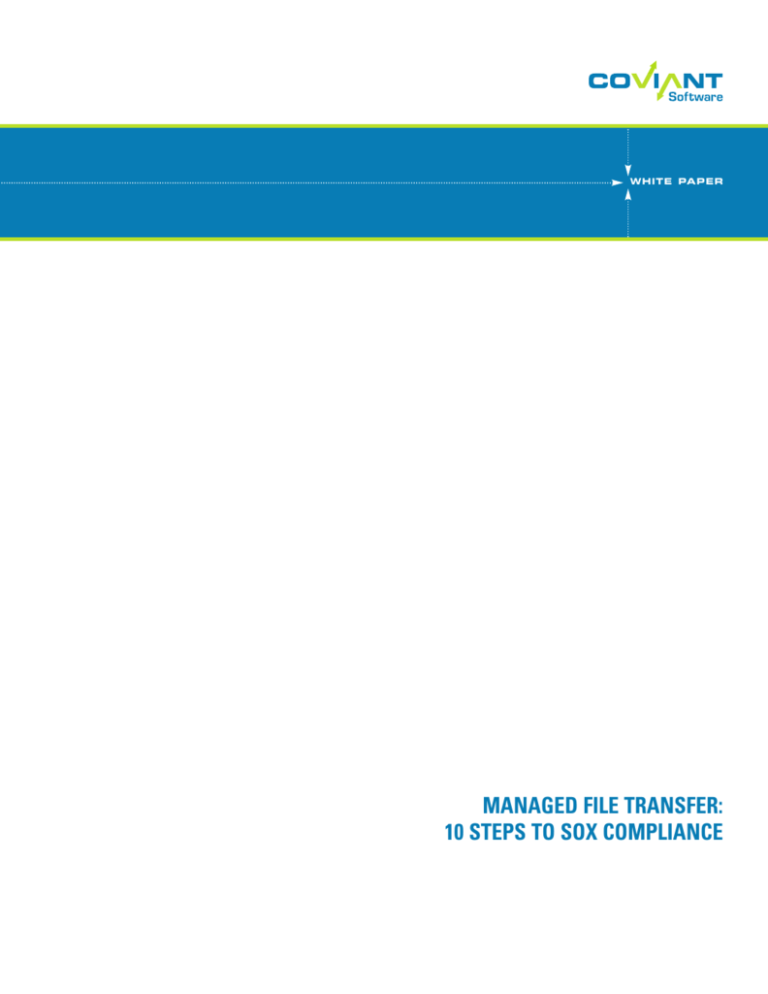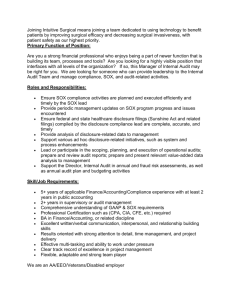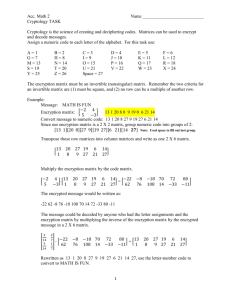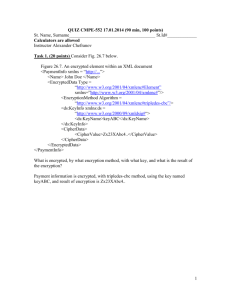
WHITE PAPER
MANAGED FILE TRANSFER:
10 STEPS TO SOX COMPLIANCE
1.
OVERVIEW
Do you want to design a file transfer process that is secure? Or one that
is compliant? Of course, the answer is “both”. But it’s not always easy
to meet that objective.
Good business practice dictates data protection for you, your customers,
and your business partners – including data-in-motion. But, even the
best security practices do not alleviate the need to demonstrate
compliance with a variety of regulations and standards that can carry
high contractual, civil, and criminal penalties. Plus, the indirect loss of
faith of your customers or business partners can have an incalculable
impact on your bottom line.
Most organizations require that all file transfers are secured.
In particular, all public companies must comply with the SOX (SarbanesOxley Act).
Often popular secure protocols, such as SSL or SSH, are used when
data is transmitted outside the corporate firewall to customers, business
partners, or other departments. Although secure protocols support a
secure and compliant file transfer process, they are only one component
in ensuring that your security goals are met. Delivering security and
compliance with your file transfer process requires a Managed File
Transfer solution to ensure that your data is protected at all times.
Although secure protocols
support a secure and compliant
file transfer process, they are
only one component in ensuring
your security goals are met.
Coviant® Software offers Diplomat® Transaction Manager, a suite of
Managed File Transfer products that secure data-in-motion and improve
SOX compliance. Diplomat Transaction Manager brings together the
security and workflow management features that IT and security
professionals need in an easy to implement, cost- effective Managed File
Transfer solution for automating your secure file transfer process.
Knowing whether your file transfer process complies with SOX can be
difficult. Since SOX regulations are based on objectives, you need to
interpret these objectives and create an action plan to design a secure file
transfer solution that meets them.
This white paper helps IT and security professionals who need to
successfully implement and manage file transfer processes that meet
both compliance and security mandates. First, 10 practical steps to
automate your secure file transfer process are detailed. The paper then
reviews the sections of SOX (based on the COBIT framework) that relate
to secure file transfer processes and how the 10 steps can meet the SOX
control objectives.
MANAGED FILE TRANSFER: 10 STEPS TO SOX COMPLIANCE
1
10 STEPS TO SECURE
FILE TRANSFER
2.
STEP 1: CREATE A SECURE CONFIGURATION
Secure file transfer requires a solution that spans the corporate firewall.
One part of the solution, such as a secure FTP or web server, is located
outside the firewall and acts as a temporary repository for files being
transferred between business partners or other entities. Another part of
the solution, such as a Managed File Transfer solution, resides in
a secure location inside the corporate firewall and manages file
transfers to and from the FTP server. Secure FTP servers are popular
among business partners that want to standardize on non-proprietary
solutions. To ensure file transfer security, only the secure FTP server
should be outside the internal firewall and a Managed File Transfer
solution, such as Diplomat Transaction Manager, must be safely inside
the internal firewall.
FIG. 1 – SECURE FILE TRANSFER CONFIGURATION
Job Scheduler
Data Source
2
COVIANT SOFTWARE
File Transfer
Manager
STEP 2: CONTROL ACCESS
STEP 3: AUTOMATE TRANSFERS
Control access to your file transfer solution. Both the FTP or web server
and the Managed File Transfer software must be designed and
implemented to limit and monitor access when setting up file transfers
and when file transfer jobs are run. Limiting users, tasks, and data
accessibility prevents unintended errors and makes it more difficult for
outsiders to successfully breach your file transfer solution.
Automate file transfers to reduce errors and limit access to sensitive
information. A file transfer solution must allow you to run jobs on an
automated schedule using the job scheduler of your choice. You need
the flexibility to use an internal scheduler that comes with the file
transfer solution, a system scheduler (e.g., Windows Scheduler), or
a scheduler in a separate application to kick off file transfer jobs that
integrate with your business workflow.
Set up access controls during implementation of your Managed File
Transfer solution to:
Protect internal communications. Most administrative
consoles for FTP or web servers and Managed File Transfer
software use client connections to communicate when setting up
file transfer tasks. These client connections should be encrypted
with SSL or other secure protocol.
Encrypt access data. File transfer solutions should always
encrypt sensitive data at rest and only decrypt it as needed, such as
when the application is started or when file transfer jobs are
executed. Encryption of user IDs, accounts, passwords, and
encryption pass-phrases prevents unintended use of the access
information. Be careful to avoid file transfer applications that store
data in plaintext, such as batch files or registry entries.
Create unique user accounts. Any user uploading
or downloading files from your FTP or web server needs to
be uniquely identifiable with a user ID and password. Disable
anonymous connections. Require complex alphanumeric passwords
that must be updated at least every 90 days. Having individual
accounts for each of your business partners or other internal groups
means you can swiftly shut down accounts in the event of a
possible security breach.
Limit privileges on accounts. Each new FTP or web server
account creates a potential point of access to your secure file
transfer solution. When setting up new accounts, strictly limit
privileges based on the precise needs of each user. Restrict
access to only one default directory for each account. Restrict
read, write, and delete privileges based on whether the user
will be sending or receiving files from your server. If possible,
restrict access to a limited set of IP addresses.
Running jobs automatically means that you can eliminate the
hit-and-miss execution of file transfer jobs using a manual process. Jobs
run on time. Plus, the correct encryption key and logon information
eliminate the possible introduction of a variety of security errors into the
file transfer process.
Automate file transfers to
reduce errors and limit access
to sensitive information.
Automated job execution means that users do not need to know
sensitive access information, such as user names, passwords, and
pass-phrases. Each manual intervention required to complete a secure
file transfer creates an opportunity for user error and for capture
of sensitive passwords or pass-phrases. Look for file transfer solutions
where access information can be entered once and used as needed
at run-time.
Terminate inactive sessions. Each unattended administrative
logon and each FTP or web session can create easy access to
secure file transfer management software, as well as to data on
FTP servers. Each logon should be set to automatically terminate
after a specified period of time.
MANAGED FILE TRANSFER: 10 STEPS TO SOX COMPLIANCE
3
STEP 4: AUTHENTICATE USERS AND PROCESSES
STEP 5: ENCRYPT FILES
Require user authentication. User authentication ensures that only a
limited number of known users with unique privileges can access your
file transfer solution. Linking authentication to each user’s network or
local logon identity both simplifies user authentication with a single
sign-on and strengthens security by ensuring that only named users
have access to file transfer set-up tasks.
Encrypt all files before they leave the corporate firewall. Data files
should be encrypted in a secure area before transfer to an FTP or web
server in the DMZ. Using secure transmission protocols only protects data
in transit. As soon as files are at rest on a server in the DMZ, they are
vulnerable to attack. Some FTP servers offer data encryption, but these
solutions can create a security loophole by waiting until files are in an
internet-accessible location before encryption.
Track all user activity. A file transfer solution must capture user activity
data each time file transfer set-up data is changed. Knowing when file
transfer set-up data was changed and who changed it provides an audit
trail that simplifies the tracking and correction of problems.
Authenticate all processes making file transfer requests. When an
automated process initiates a file transfer job, the process must be
authenticated much like a user might need to log into an application to
manually encrypt, sign, and transfer a file. Any file transfer solution needs
to authenticate job processes that attempt to initiate file transfer jobs.
A process that requests a file transfer job be run can be authenticated
with a password, user ID of the process making the request, or other
authentication method.
User authentication ensures only
a limited number of known users
have access to your managed file
transfer solution.
4
COVIANT SOFTWARE
Select a solid, widely-used encryption standard, such as OpenPGP.
OpenPGP is one of the oldest public key encryption technologies.
Because of its popularity, many users spend time attempting to find
vulnerabilities in it. And, when vulnerabilities are found, they are
rapidly addressed.
Use good encryption practices. Strong encryption algorithms are
important, but good encryption practices are equally valuable in
decreasing the possibility of a file being breached. Create the minimum
number of keys required to meet your business needs. If you select
OpenPGP for file encryption, you have the option of using multiple
encryption sub-keys with consecutive validity periods. Each new
encryption sub-key provides the same security as creating a new key
pair without the administrative hassle of sending a new public key to
your business partners. When you create a new OpenPGP key pair, set
up multiple encryption sub-keys that are valid for short intervals, such as
a year or less.
STEP 6: SIGN AND VERIFY FILES
Sign and verify files to ensure integrity and non-repudiation. Sign all
outbound data files and check for valid signatures on all inbound files.
Signing and verification are the best way to guarantee non-repudiation
of origin and to ensure decrypted files are safe to process. Verifying
signatures on every file ensures that the files you receive have not been
altered during transit and confirms the identity of the sender.
With an encryption standard like OpenPGP, a signature is created and
affixed to a file before it is encrypted in preparation for outbound
transmission. The private key of the sender is used to create the signature.
Without a signature, a recipient has no way to determine the sender of
the file. When the file is received, the file is decrypted and the signature
can be examined before the file is processed. Signatures are used to
determine the sender of the file – as only the public key of the sender
can successfully verify a signature. If the signature verification fails,
then the file should not be processed.
Signatures verify the integrity of files. Part of the signature contains a
hash of the original file. As part of the signature verification process, the
hash is recalculated using the decrypted file and compared to the hash
in the original signature attached to the file. Matching hashes mean that
the file has not been altered since the signature was attached. In other
words, the integrity of the decrypted file has been confirmed and it is
safe to be processed.
Sign and verify files to ensure
data integrity and non-repudiation
of origin.
STEP 7: USE SECURE PROTOCOLS
Use secure transmission protocols to protect logon data and add an
extra layer of protection to encrypted files being transferred.
Secure protocols protect logon data during each user access. File
encryption protects your data, but does not protect the logon data used
to access an FTP or web server. Secure protocols establish a secure
connection with an FTP or web server before sending the logon data
used to authenticate a user, such as usernames, passwords, and keys.
If attackers capture logon data, they can initiate other file transfer jobs
and potentially transmit files with malicious content.
Without secure transmission protocols, an encrypted file can be
captured intact during transit. Once the encrypted file is in their
possession, attackers can work on decrypting the file at their leisure.
Using a secure protocol provides an additional layer of encryption that
must be penetrated before a file is compromised.
MANAGED FILE TRANSFER: 10 STEPS TO SOX COMPLIANCE
5
STEP 9: CAPTURE AUDIT DATA
Use audit data strategically to
demonstrate comprehensive
data security and regulatory
compliance.
Capture audit data to demonstrate regulatory and internal audit
compliance. Audit data can be used strategically to demonstrate
regulatory compliance or tactically to confirm to a business partner the
encryption key and destination location used by a specific file transfer
job.
Proving that you have a secure file transfer process can be an arduous
task. Audit data needs to be both comprehensive and easy to analyze.
Your file transfer solution needs to capture extensive data in a standard
format, such as a SQL database. Two types of audit data are critical:
Job and file data. Detailed information on each file transfer job
and each file transferred can demonstrate that secure procedures,
such as encrypting files before transfer and use of secure transmission
protocols, were used for each file transferred.
STEP 8: ARCHIVE ENCRYPTED FILES
Encrypt data files with your own master key before archiving. Archived
files can be essential component in providing the business a record of
information that has been transferred. These archived files need to be
equally as secure as the files that were transferred. Archival of encrypted
files provides protection in case of an internal security breach, but you
must be able to decrypt the archived files when they are needed.
Encrypting archival copies of files to your own master key before storing
in a secure location creates a repository of secure files that are safe and
meet your business needs.
Don’t keep archive files that you can't decrypt. When you are encrypting
files to be sent to your business partners, you use their public key. You
will not be able to decrypt these encrypted files unless you also encrypt
them with your own master key.
6
COVIANT SOFTWARE
User activity data. Data on who accessed your file transfer
solution is equally as important. If files were transferred incorrectly,
questions of who may have set up or updated the file transfers may
become critical.
The integrity of audit data must also be ensured. If you capture audit
data into files, limit the user identities that are allowed to write, alter,
or delete audit files. If you use database technology, such as SQL, limit
write access to the audit tables to the identity used by the file transfer
management software.
STEP 10: MONITOR FILE TRANSFERS
Monitor file transfer jobs to rapidly identify potential security problems.
Automating file transfer jobs does not guarantee that no issues will
arise at run-time. Your file transfer solution needs to provide real-time
information. A job not running on schedule or taking too long to
complete may signal a security problem.
When a file transfer job fails, the support person responsible for
the job needs to be alerted as soon as possible. Email and/or paging
notifications need to be sent, including the information (e.g., log entries)
needed to diagnose and correct the problem.
Creating a secure file transfer
process does not always
guarantee that all regulations
and standards will be met.
If a security breach occurs unrelated to a file transfer (e.g., an FTP
server or encryption key has been compromised), the specific file transfer
jobs affected may need to be suspended until the security breach has
been corrected.
3.
MEETING SOX
REGULATIONS
Creating a secure file transfer process does not always guarantee that
all regulations and standards will be met. Mandates, like SOX, are
intended to protect the privacy and security of data. SOX covers a wide
range of control objectives. Only some of which are pertinent when
designing and implementing a managed file transfer solution. The
following figure identifies the portions of SOX that affect file transfer
security and how the 10 Steps to Managed File Transfer can meet those
mandates.
MANAGED FILE TRANSFER: 10 STEPS TO SOX COMPLIANCE
7
FIG. 2 – COBIT DELIVERY AND SUPPORT CONTROL OBJECTIVES
DS5 ENSURE SYSTEMS SECURITY
DS5.3
Identity
Management
10 STEPS TO
SECURE FILE
TRANSFER
IMPLEMENTATION
1. Secure configuration
2. Control access
Ensure that all users
and their activity on
IT systems are
uniquely identifiable.
Enable user
identities via
authentication
mechanisms …
Maintain user
identities and
access rights in a
central repository …
Establish user
identification,
implement
authentication
and enforce
access rights.
DS5.5
Security
Testing,
Surveillance
DS5.6
Security
Incident
Definition
DS5.7
Protection
of Security
Technology
DS5.8
Cryptographic
Key
Management
Test and monitor
the IT security
implementation in
a proactive way
…A logging and
monitoring function
will enable the early
prevention and/
or detection and
subsequent timely
reporting of unusual
and/or abnormal
activities that may
need to be
addressed.
Clearly define and
communicate the
characteristics of
potential security
incidents so they
can be properly
classified and
treated by the
incident and
problem
management
process.
Make securityrelated technology
resistant to
tampering, and
do not disclose
security
documentation
unnecessarily.
Determine that
policies and
procedures are in
place to organize
the generation,
change, revocation,
destruction,
distribution,
certification,
storage, entry, use
and archiving of
cryptographic
keys to ensure the
protection of keys
against modification
and unauthorized
disclosure.
•
•
4. Authenticate users/
processes
DS5.11
Exchange of
Sensitive Data
Use security
techniques and
related
management
procedures (e.g.,
firewalls, security
appliances, network
segmentation,
intrusion detection)
to authorize access
and control
information flows
from and to
networks.
Exchange sensitive
transaction data
only over a trusted
path or medium
with controls to
provide authenticity
of content, proof
of submission,
proof of receipt
and non-repudiation
of origin.
•
•
•
•
•
3. Automate transfers
DS5.10
Network
Security
•
•
5. Encrypt files
6. Sign and verify files
7. Use secure protocols
•
•
•
8. Archive encrypted files
9. Capture audit data
10. Monitor file transfers
•
•
•
The Sarbanes-Oxley Act mandates that all publicly-traded organizations
demonstrate due diligence in the disclosure of financial information.
Each organization must also implement internal controls and procedures
to protect financial data from unauthorized access, including access that
could occur through file transfers. Developed by the IT Governance
Institute, the COBIT (Control Objectives for Information and related
Technology) control objectives is an open framework that is often used
to design IT controls to comply with the Sarbanes-Oxley Act.
8
COVIANT SOFTWARE
The COBIT framework is based on four domains containing 34 IT processes
and over 300 detailed control objectives. The primary processes of interest
to IT organizations selecting and implementing secure file transfer
solutions are in the Delivery and Support (DS) domain. The pertinent
control objectives for secure file transfer are primarily under DS5 Ensure
Systems Security. Control objectives that are most relevant to secure file
transfer are shown above in FIG. 2. Complete documentation on the
COBIT framework and process can be found at http://www.itgi.org.
4.
SUMMARY
Both security and compliance are essential to smooth operations
and business continuity. Developing a Managed File Transfer
implementation can also meet the key objectives that are critical
for compliance with industry mandates, such as SOX. Focus on
10 PRACTICAL STEPS to meet your security and compliance needs:
STEP 1:
STEP 2:
STEP 3:
STEP 4:
STEP 5:
STEP 6:
STEP 7:
STEP 8:
STEP 9:
STEP 10:
Secure configuration
Control access
Automate transfers
Authenticate users and processes
Encrypt files
Sign and verify files
Use secure protocols
Archive encrypted files
Capture audit data
Monitor file transfers
Coviant Software offers Diplomat
Transaction Manager, a suite of
Managed File Transfer products
that secure data in transit and
improve compliance with
SOX requirements.
ABOUT COVIANT SOFTWARE
Coviant Software delivers Managed File Transfer solutions to improve the productivity of file transfer administrators. Diplomat Managed File
Transfer software uses Intelligent File Transfer™ design with embedded secure file transfer logic, so file transfer experts can quickly design and
deploy file transfer jobs with fewer errors and failed transfers.
For more information or to download trial software, visit www.coviantsoftware.com or email us at sales@coviantsoftware.com.
781.210.3110 T / 781.210.3313 F / www.coviantsoftware.com
© 2008-2014 Coviant Software. All rights reserved. Coviant and Diplomat are registered trademarks of Coviant Software Corporation.
All other company and product names are trademarks or registered trademarks of their respective owners.








